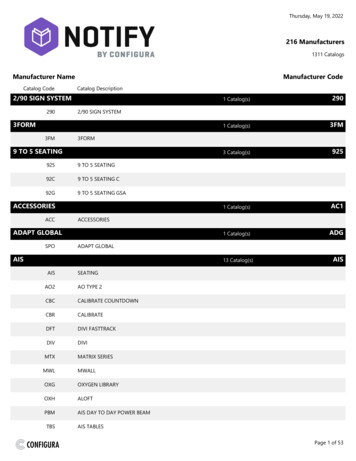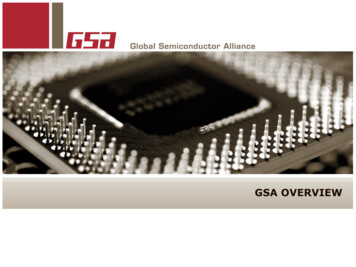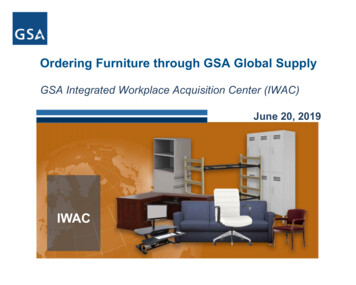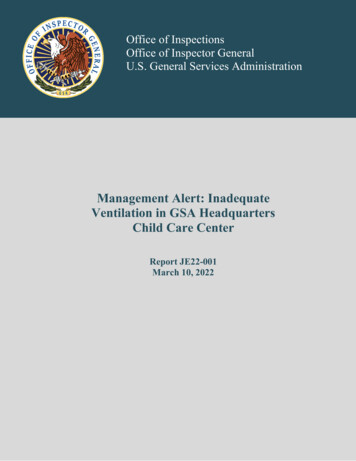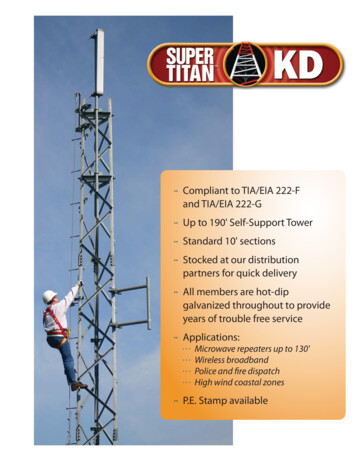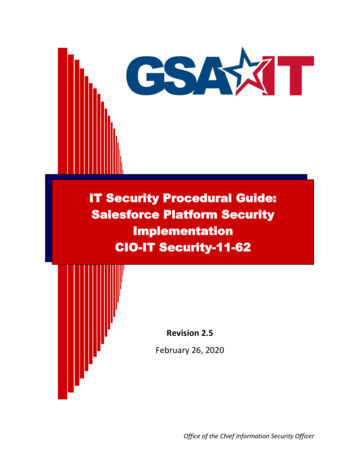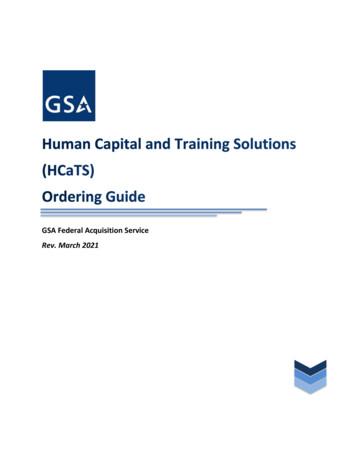
Transcription
GSA Federal Acquisition ServiceRev. March 2021
Table of ContentsWho is this Guide Written for? .4Who Can Use HCaTS? .4How to Begin Using HCaTS? .4How to Request DPA Training? .4Roles and Responsibilities .5Rights Reserved by the Procuring Contracting Officer .5What are some of the benefits of using HCaTS? .6Options for Accessing the HCaTS Contracts .6HCaTS Program Background .7Scope of HCaTS .7Out of Scope Services .7HCaTS Vehicles/Pools/NAICS .8HCaTS is comprised of two major vehicles and one sub-vehicle: .81.HCaTS Unrestricted (HCaTS-U).8Each of the vehicles are consists of two Pools covering different NAICS codes and size standards. All NAICS codesin each Pool have the same Small Business Size Standard. Some contractors won contracts in more than onePool/SubPool and were awarded separate contracts for each of them. The current HCaTS Pools are as follows: .8The Ordering Process .9Step 1: Acquisition Planning .9Which HCaTS Vehicle to Use: HCaTS Unrestricted or HCaTS SB or HcaTS 8(a)? .9Set-Asides for Socioeconomic Competition under HCaTS SB .10Special Instructions Regarding Orders Set-Aside for 8(a) .10Task Order Contract Types .11Assign a NAICS Code to Each Order .2Task Order Funding and Funding Limitations .2Minimum and Maximum Order Limitations.2Task Order Size Representation .3Task Order Duration .3Task Order Small Business Size Representation .3Labor Categories for Task Order Work .3Other Direct Costs (ODC) and Ancillary Support .4Security Clearance Considerations for Classified Orders .5Labor on T&M and L-H Task Orders .52 of 14
Service Category Labor Standards (SCLS) .5FAR Clause 52.204-14, Service Contract Reporting Requirements .5Rights in Data .6Contract Access Fee (CAF) .6Other Significant Planning Considerations .6HCaTS Tools and Planning Resources .7Scope Determination: .7Step 2: Define the Requirements .7Requirements Development Support Resources .7Price Estimating and Developing IGCE .7Developing the Solicitation .8Clauses and Provisions .8Evaluation Factors .9Step 3: Issue the Solicitation.9Methods of Issuing the Task Order Solicitation .9Contractors in Dormant Status .10Step 4: Evaluate Proposals.10Price Fair and Reasonable Determination .11Step 5: Award the Task Order .11Order Award Documentation .11GSA Task Order Award and Modification Information .11Public Notice of Awards Not Providing for Fair Opportunity .11Order Level Protests .11Ombudsman .12Reporting Task Order Awards in FPDS-NG .12Post-Award Survey .12Step 6: Task Order Administration .12Reporting Modifications in FPDS-NG .12Reporting Modifications to GSA .13Subcontracting and Limitations on Subcontracting .13Performance Evaluation .13Step 7: Task Order Closeout .13HCaTS TOOLS & RESOURCES .143 of 14
Who is this Guide Written for?This guide is written for warranted Federal Ordering Contracting Officers (OCOs) considering using theHCaTS contract vehicles. This guide addresses contracting issues and concepts unique to HCaTScontracts; however, OCOs shall follow FAR regulations and their agency specific policies as well adhereto the terms of the contract. This ordering guide presumes that OCOs are proficient in their duties, witha working knowledge of all applicable Federal regulations, executive orders, and human capital andagency policies.Additional information to assist customer agencies in using the HCaTS contracts is also available onlineat www.gsa.gov/HCaTS. The HCaTS website includes the following resources: HCaTS ContractsResource Directory: Task Order samples, Templates, and ReportsPre-Award Scope Review processHCaTS Training and Delegation of Procurement Authority (DPA) processList of Awarded ContractorsWho Can Use HCaTS?The HCaTS contracts may be used by all Federal agencies and other entities as listed in the GSA Order,OGP 4800.2I, Eligibility to use GSA Sources of Supply and Services, as amended.For purposes of HCaTS Contracts authorized users are identified as OCOs. Only an authorized user, whois a delegated OCO, may solicit, award, and administer a task order under HCaTS Contracts. In order toqualify as an authorized user, a duly warranted Contracting Officer of the Federal Government, asdefined in FAR Subpart 2.101, in good standing, must have received a Delegation of ProcurementAuthority (DPA) from the HCaTS PMO.Contractor employees authorized under FAR 51.1 Contractor Use of Government Supply Sources to useHCaTS are considered OCOs and are not required to obtain a DPA as their authority is granted to themby a Federal Government Contracting Officer administering an applicable contract (e.g.,a FFRDC).How to Begin Using HCaTS?In order to solicit and place a task order under HCaTS, the OCO must first obtain a Delegation ofProcurement Authority (DPA) from the HCaTS Contracting Officer. In order to do this, you must: Be a warranted Federal Contracting Officer (CO) in good standingFormally apply for and receive DPA trainingHow to Request DPA Training?4 of 14
DPA Training is approximately 60 minutes long and is provided through an online meeting space, or inperson. To request DPA training, visit HCaTS.gsa.gov. For an on-site training, email us atHCaTStraining@gsa.gov.Roles and ResponsibilitiesDPAs are issued to individual contracting officers, not agencies at large. There is no limit to the numberof DPAs that can be issued to Contracting Officers within an Agency. An OCO with a DPA has theauthority to solicit, award, administer, and modify task orders against the HCaTS Contracts.The OCO shall comply with the HCaTS master contract terms and conditions, the Ordering Guide, theFederal Acquisition Regulation (FAR) and authorized agency supplement or exception, applicableagency-specific statutes and policies, and the additional responsibilities defined in the HCaTS DPAcertification.OCO duties include, but are not limited to: Task order scope compliance with HCaTS Certify funds availability and allocate funds for requirements Process disputes, claims, or protests under HCaTS Request and receive a DPA prior to soliciting and awarding a task order under HCaTS Comply with the terms and conditions of the HCaTS contracts Comply with the ordering procedures outlined in FAR Subpart 16.505 and other agency specificregulatory supplements Issue task order solicitations under the proper HCaTS MA-IDIQ contract numbers Comply with Inherently Governmental Functions policy as outlined in FAR 7.503 Allow a reasonable time for fair opportunity proposal submission Resolve any performance issues, disputes, claims or protests at the task order level Respond to all Freedom of Information Act (FOIA) requests at the task order level Enter task order performance evaluation in the Contractor Performance Assessment ReportingSystem (CPARS) or alternative past performance assessment reporting system mandated bycustomer agencies that do not require the use of CPARS Close out task orders in a timely mannerRights Reserved by the Procuring Contracting OfficerThe HCaTS CO is the sole and exclusive GSA Government official with actual authority to administer andmodify the HCaTS contracts terms and conditions, monitor contractor performance in the areas ofcontract compliance and contract administration, and assist the contractor and OCO on matters relatedto the HCaTS terms and conditions.5 of 14
The OCO for each task order may designate a Contracting Officer Representative (COR) to performspecific administrative or technical functions. The specific rights and responsibilities of the COR for eachtask order shall be described in writing, which upon request, shall be provided to the contractor. A CORhas no actual, apparent, or implied authority to bind the Government. OCOs may not transfer delegationof procurement authority to a non-delegated Contracting Officer.What are some of the benefits of using HCaTS?HCaTS is flexible, easy to use, and allows agencies to: Allows for all contract types at the task order level: Fixed-Price (all types), Cost-Type, Time-andMaterials, and Labor-Hour, including hybrid mixtures of contract types Utilize incentives, performance based measures Establish a CLIN structure tailored to individual task order requirements Help in achieving agency small business and socioeconomic goals Small business subcontracting plans have already been incorporated and administered by theHCaTS PMO office for other than small businesses Include Other Direct Costs (ODCs) and Ancillary Support at the task order level as needed Access templates and sample acquisition documents Acknowledge that responsibility determinations have already been completed for all contractholders in accordance with FAR Part 9, at the master contract level Share lessons-learned and best practicesOptions for Accessing the HCaTS ContractsAgencies can use HCaTS in two ways:1. Direct Buy: Agencies with designated OCOs may issue orders directly against HCaTS; the onlyrequirement is that the OCOs obtain a DPA certificate prior to using the HCaTS. The buyingactivity is responsible to conduct all the acquisition actions, from acquisition planning to taskorder completion and close out. If you consider using HCaTS via Direct-Buy, see the section“How to Begin Using HCaTS”.2. Assisted Acquisition Service (AAS): Agencies may enter into a Memorandum of Agreement(MOA) with GSA to issue a task order. MOA’s can be for cradle-to-grave services. GSA hasspecific statutory authority under 40 U.S.C 501 to purchase supplies and non-personal serviceson behalf of other agencies. Therefore, the Economy Act does not apply to HCaTS orders.Additionally, AAS offers value-added, customized, acquisition, project management, and6 of 14
financial management services for large and/or complex solutions. To learn more about AAS,visit www.gsa.gov/r2assistedacquisition.HCaTS Program BackgroundThe General Services Administration (GSA) and the Office of Personnel Management (OPM) formed apartnership to jointly award and administer a strategically sourced contract vehicle for human capitaland training solutions. Through this partnership, GSA is principally responsible for contractadministration, while OPM is responsible for policy oversight.HCaTS provides a common architecture and platform across the Federal Government for the acquisitionof complex human capital and training requirements. The HCaTS Program Contracts are intended toprovide human capital and training solutions through the effort of bona fide executive, administrative,and professional employees as defined in Part 541 of Title 29, Code of Federal Regulations (CFR).Scope of HCaTSHCaTS and HCaTS Small Business (HCaTS SB) contracts refer to the master contracts of which theapplicable terms, conditions, and clauses flow down to all HCaTS task orders. The services coveredunder the HCaTS Program can span across three Key Service Areas (KSAs):KSA 1: Customized Training and Development ServicesKSA 2: Customized Human Capital Strategy ServicesKSA 3: Customized Organizational Performance ImprovementAdditionally, the scope allows for ancillary services and costs necessary to complete a total solutionprocurement. Services under the HCaTS Program may be commercial and/or non-commercial, classifiedand non-classified, CONUS and OCONUS. All HCaTS Task Orders must be within the scope of one ormore of HCaTS’ KSAs. Review Section C of the HCaTS Program Contracts for a complete description ofthe scope.Out of Scope ServicesThe following requirements are prohibited under HCaTS scope: Inherently Governmental Functions – See FAR Subpart 7.5 and Office of FederalProcurement Policy (OFPP) Policy Letter 11-01 Personal services contracts – FAR Paragraph 37.104(a) Architectural & Engineering (A&E) Services subject to the Brooks Act and FAR Part 36acquisition procedures7 of 14
A requirement that primarily uses employees not employed in a bona fide executive,administrative, or professional capacity as defined in 29 CFR Part 541 and/or employeesprimarily employed as laborers or mechanics – FAR Section 22.401 Requirements where the primary purpose is the development of information technology asdefined by FAR Section 2.101 and HCaTS Program Contracts Section C.3.3 Requirements where the primary purpose is temporary services as defined by FAR Section37.112 and HCaTS Program Contracts Section C.3.4.HCaTS Vehicles/Pools/NAICSHCaTS is comprised of two major vehicles and one sub-vehicle:1. HCaTS Unrestricted (HCaTS-U)2.a HCaTS Small Business (HCaTS SB)2.b HCaTS 8(a)Each of the vehicles are consists of two Pools covering different NAICS codes and size standards. AllNAICS codes in each Pool have the same Small Business Size Standard. Some contractors won contractsin more than one Pool/SubPool and were awarded separate contracts for each of them. The currentHCaTS Pools are as follows:Pool 1 – Size Standard 12M611430, Professional and Management Development Training (Primary NAICS)611699, All Other Miscellaneous Schools and Instruction624310, Vocational Rehabilitation ServicesPool 2 – Size Standard 16.5M Size Standard541611, Administrative Management and General Management Consulting Services541612, Human Resources Consulting Services (Primary NAICS)541613, Marketing Consulting Services541618, Other Management Consulting Services611710, Educational Support ServicesHCaTS Contractors:The list of HCaTS contract holders and their socio-economic status under each vehicle and pool isavailable on:- GSA eLibrary (gsaelibrary.gsa.gov): Search for “HCaTS”.- HCaTS Website (gsa.gov/hcats): under “Buyer Guidance and Resources”.8 of 14
The Ordering ProcessHCaTS is a Multi-award IDIQ contract; when using HCaTS, OCOs must follow FAR Subpart 16.5 forordering processes. Additionally, OCOs shall follow FAR Subpart 16.3 and FAR Parts 30 and 31 for costreimbursement task orders unless an authorized exception applies. Fair opportunity procedures inaccordance with FAR Paragraph 16.505(b)(1) prescribed for the dollar value of the task order must beused. When the OCO plans to award a task order based on an exception to fair opportunity, applicablejustifications and approvals in accordance with FAR Subpart 16.505(b)(2) must be prepared andobtained.Step 1: Acquisition PlanningOrders against MA-IDIQ contracts, such as HCaTS, are not exempt from Acquisition Planning asprescribed in FAR Part 7. Conduct market research for your requirement in accordance with regulationsas you would do with any procurement. You are encouraged to issue Requests for Information (RFI),draft solicitations, and other documents to HCaTS contract holders as part of your market researchefforts.Generally, OCOs shall follow the ordering procedures in FAR Subpart 16.505. Unless an authorizedexception applies, fair opportunity procedures prescribed for the dollar value of the task order must beused. When the OCO plans to award an order based on an exception to fair opportunity, applicableJustifications and Approvals should be prepared as part of the planning process. Any required noticesand postings must also be issued.Which HCaTS Vehicle to Use: HCaTS Unrestricted or HCaTS SB or HcaTS8(a)?Which HCaTS vehicle you will use depends on the determination made in the acquisition planningprocess as to whether or not your requirement should be set-aside for small business. Agencies havediffering standards, interpretations, and policies regarding set-aside determinations. GSA encouragesthe practice of considering the small business awardees to fill your requirement first. The determinationto set-aside a procurement for small business or not is part of the acquisition planning process and to bedone prior to contract type selection. The HCaTS program office offer no opinion on any agency’sdecision making process concerning this issue.When a small business set-aside is to be accomplished, use HCaTS SB as these contracts are awardedexclusively to small businesses. When a small business set-aside will not be accomplished and Full andOpen is appropriate, use HCaTS Unrestricted. For 100% small business set-aside - Must use HCaTS SBFor WOSB/EDWOSB/VOSB/SDVOSB/HubZone Set-Aside - Must use HCaTS SBFor 8(a) Direct/Competitive Set-Aside - Must use HCaTS 8(a)9 of 14
For Full and Open - Must use HCaTS USet-Asides for Socioeconomic Competition under HCaTS SBHCaTS Small Business (SB) is a total small business set-aside contract. All orders issued under HCaTS SBare automatically considered set-aside for small business as only small businesses were awarded anHCaTS SB contract.Unless the order solicitation explicitly requires size/socioeconomic recertification at the order level, theOCO shall rely on the size/socioeconomic status shown in the HCaTS SB Contractor List available here:www.gsa.gov/HCaTS. All HCaTS SB Contractors’ size/socioeconomic status remains unchanged for eachof their HCaTS SB contracts unless modified by a FAR 52.219-28 re-representation or due to a novation,merger, or acquisition IAW HCaTS Contracts Section G.3.10.The OCO has discretionary authority under FAR 19.502-4(c) and FAR 16.505(b)(2)(F) to further set-asideorders for any of the small business concerns identified in FAR 19.000(a)(3) when it is anticipated thatquotes will be obtained from at least two eligible small business concerns for which the order is to beset-aside.-HUBZone Small Business concernsService-Disabled Veteran-Owned Small Business (SDVOSB) concerns* Economically Disadvantaged Women-Owned Small Business (EDWOSB) concerns* Women-Owned Small Business (WOSB) concerns* EDWOSB and WOSB competitive set-asides are subject to specific NAICS industry groups in whichEDWOSBs and WOSBs are underrepresented. The eligible NAICS Codes for EDWOSB and WOSB setasides are subject to change by the SBA. See sba.gov/wosb for the updated list of NAICS Codes todetermine HCaTS SB Pool NAICS availability for EDWOSB or WOSB set-asides.Small businesses retain their small business size status and socio-economic status during the orderingperiod under HCaTS SB. Accordingly, OCOs should not use SAM to determine the size status applicableto an HCaTS SB vendor. For HCaTS contractors, OCOs should use the spreadsheet found atgsa.gov/hcats under “Who is on HCaTS” in order to determine the socioeconomic status of companies.When setting aside orders for socio-economic concerns, the specific small business program eligibilityrequirements identified in FAR Part 19 apply.Special Instructions Regarding Orders Set-Aside for 8(a)Ordering activities seeking to satisfy their requirements through either 8(a) competitive or 8(a) SoleSource (Direct) task orders must use the HCaTS 8(a) vehicle only. OCOs cannot utilize HCaTS SB Pools orHCaTS U Pools for this purpose.Competitive 8(a) Orders Follow similar procedures to competing orders under any other HCaTS Pool.10 of 14
HCaTS 8(a) Pools were set aside exclusively for 8(a) competition, so if an OCO wishes to utilize acompetitive 8(a) set aside task order, they would simply follow the fair opportunity proceduresfor soliciting to that HCaTS 8(a) Pools.May compete at any dollar level above the minimum SAT ( 250,000).All 8(a) Pool awardees have been offered and accepted by SBA into the 8(a) program at the IDIQContract Level under SBA requirement number TX1565638190Y.No need to offer the order for SBA acceptance to get 8(a) credit for the order.All competitive orders default to the size/status shown in HCaTS 8(a) Pools notwithstandingtheir size/status shown in any other system.Sole Source (Direct) 8(a) Orders Sole Source (Direct) 8(a) Orders may be issued at the OCO’s discretion subject to SBA approval.Sole Source (Direct) 8(a) orders must each be offered to and accepted by SBA before award. Inthe offer letter to SBA refer to HCaTS SBA requirement #TX1565638190Y.A firm must be a current 8(a)participant at the time of task order award in order to receive a Sole Source (Direct) order. TheOCO should check the 8(a) status at SBA Dynamic Search https://web.sba.gov/pronet/search/dsp dsbs.cfm before considering a Sole Source (Direct) order.Contractors who have exited from the 8(a) program are ineligible to receive an 8(a) Sole Source(Direct) order award.Follow your agencies’ partnership agreement for offering the Sole Source (Direct) order to agencies-partnership- agreements.In accordance with FAR 19.805-1(a)(2) the current 8(a) Sole Source (Direct) order limit is 4.5million; Except for 8(a) concerns owned by an Indian Tribe (Tribal Owned) or an Alaska NativeCorporation (ANC) (reference FAR 19.805- 1(b)(2)) which have a Sole Source(Direct) order limitof 25 million in accordance with FAR 19.808-1.Department of Defense (DoD) only: DoD may also issue Sole Source (Direct) orders to 8(a)Native Hawaiian Organizations (NHO) (reference 13 CFR 124.506(b)(2))DFARS 219.808-1 increases Sole Source (Direct) order limit to 100 million for ANC/TribalOwned/NHO 8(a) concerns.Sole Source (Direct ) 8(a) orders to ANC/Tribal Owned/NHO 8(a) concerns Notwithstanding HCaTS 8(a) Pools IDIQ contracts were awarded competitively, 13 CFR 124.506(b)(1) and (2)’s “.if SBA has not accepted the requirement into the 8(a) BD program as acompetitive procurement ” only applies to an order level requirement and may not be used as arationale to prohibit allowing orders to ANC/Tribal/NHO 8(a) concerns on a Sole Source (Direct)order basis above the FAR 19.805-1(a)(2) 4.5 million threshold.HCaTS 8(a) Pools order requirement that was initially solicited on a competitive basis may not beremoved from competition and subsequently awarded to an ANC/Tribal/NHO 8(a) concern on aSole Source (Direct) order basis.Task Order Contract TypesSubject to FAR and agency level required consideration criteria, limitations, and/or prohibitions, youmay use any appropriate contract type(s) including:11 of 14
Fixed-Price, all typesCost-TypeTime-and-MaterialsLabor-HourHybrid of any of these typesIf you elect to use a hybrid of contract types, please use a separate line item number for the work undereach contract type and annotate each line item with the associated contract type. This is important forclause implementation.Assign a NAICS Code to Each OrderThe OCO may use the IDIQ Contract primary NAICS at the task order level or select a more specific NAICSdepending on the requirement. The chart below identifies the HCaTS NAICS codes for both Pools wit
This guide is written for warranted Federal Ordering Contracting Officers (OCOs) considering using the HCaTS contract vehicles. This guide addresses contracting issues and concepts unique to HCaTS contracts; however, OCOs shall follow FAR regulations and their agency specific policies as well adhere to the terms of the contract.
